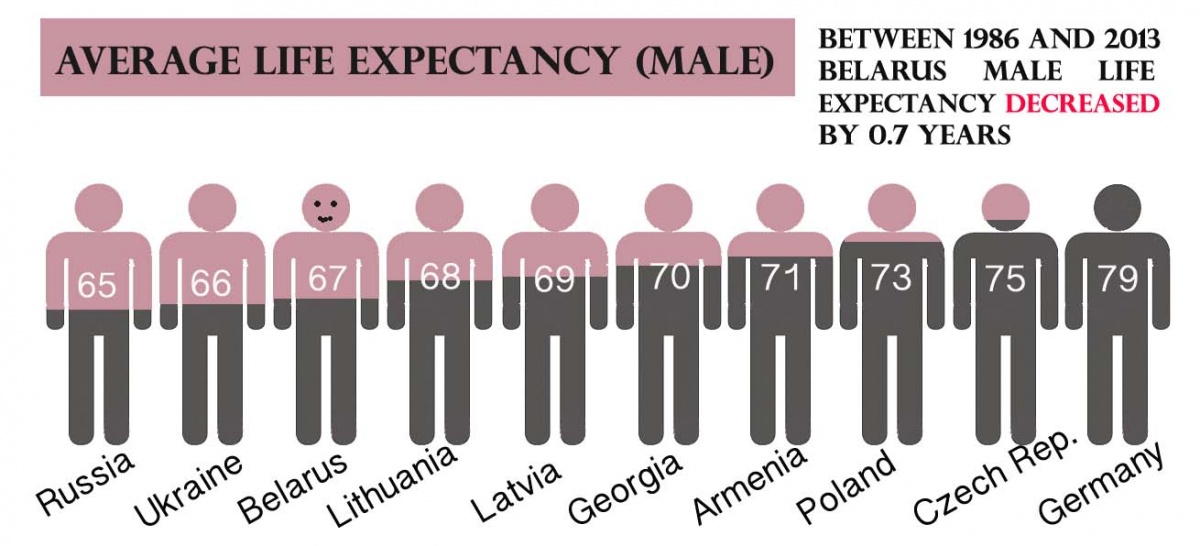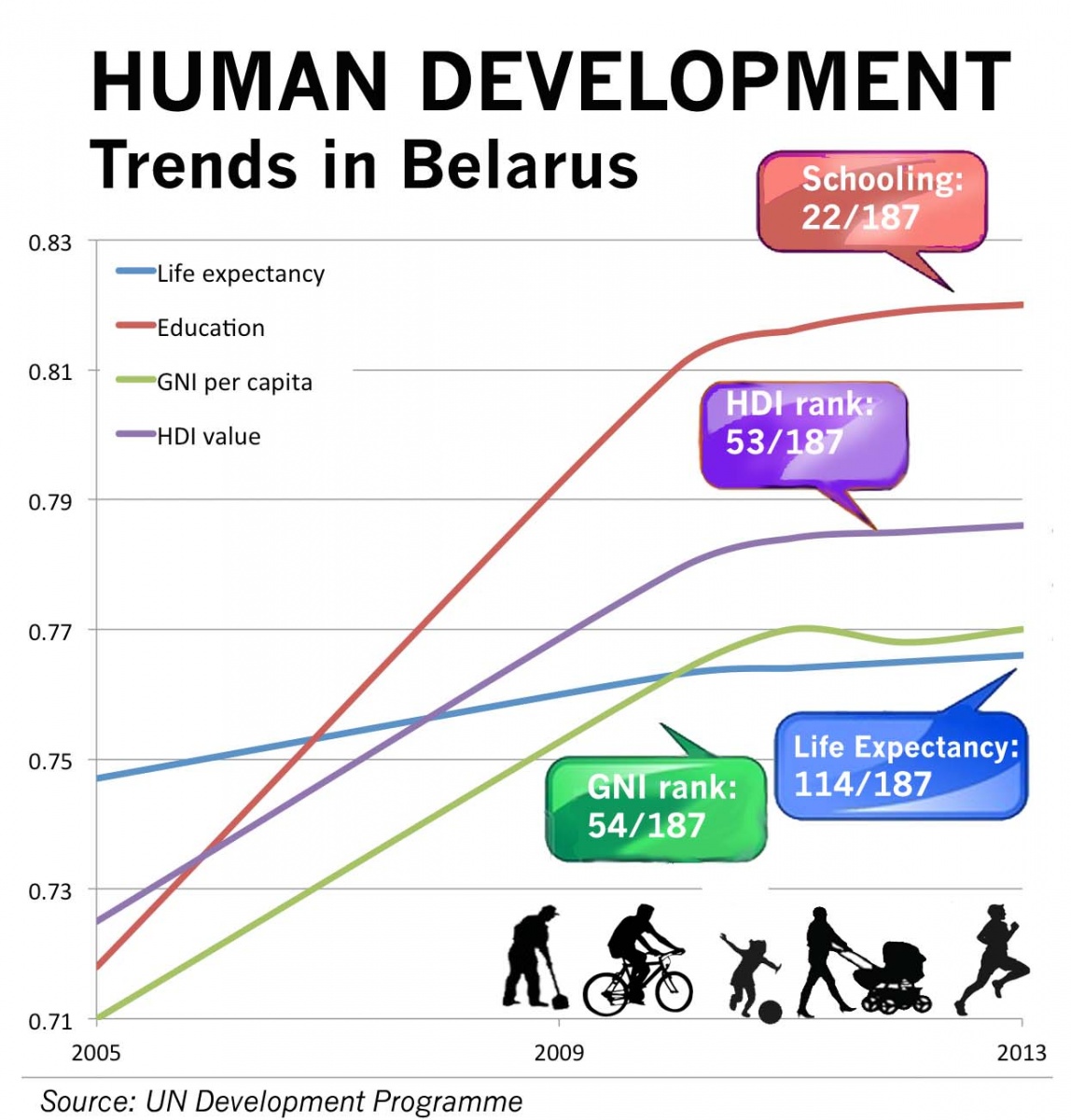Why Belarus Outranks CIS states on Human Development Index

Students learning about national symbols. Photo from belarus.by
Belarus ranks 53rd out of 187 countries in the 2014 Human Development Index (HDI). That places it ahead of fellow post-Soviet states Russia (57th), Kazakhstan (70th), and Ukraine (83rd).
To measure development, HDI underscores the importance of “people and their capabilities” rather than economic metrics. It combines three dimensions of development: population health, access to knowledge, and the standard of living.
Belarus scores extremely well on the knowledge dimension. However, it does far worse on population health and the standard of living, the other HDI components. It appears that Belarus boosted its HDI ranking largely by prolonging the time its population spends in school.
Are Belarusians living long and healthy lives?
HDI assesses population health by measuring life expectancy at birth. This component drags Belarus down in HDI rankings. Belarus’s life expectancy at birth has reached 72 years, which is five years lower than in neighbouring Poland and thirteen years below the HDI maximum value of 85 years.

Premature death of Belarusian men constitutes the main problem. Men in Belarus live an average of 66.6 years, an entire decade shorter than women.
The number has decreased since the 1980s and is now two years below the world average. About half of Belarusians who die prematurely have been smoking, drinking, or both.
Do Belarusians enjoy a decent standard of living?
The HDI standard of living component uses the logarithm of gross national income (GNI) per capita. The logarithmic transformation reflects the diminishing importance of income with increasing GNI.
Belarus’s standard of living has improved throughout the 2000s. Between 1990 and 2013, GNI per capita increased by nearly 100%. In September 2001, an average Belarusian earned merely US$ 90 per month. By 2014, the average monthly income reached US$ 603.
Belarusian IT specialists earn the highest wages (around US$1,500 per month). Despite Belarus's small size, regional income gaps persist. Minsk residents earn nearly 1.5 as much as the residents of Mahileu, the poorest part of Belarus.

Even though Belarusians’ incomes have grown, they are lower than the incomes in Belarus’s Customs Union partners – Russia and Kazakhstan. Moscow remains a key destination for Belarusians searching for higher-paying jobs.
How useful is education for Belarusians?
Education is where Belarus excels. An average Belarusian attends school for eleven-and-a-half years. Belarusian children are expected to study for nearly sixteen years – only two years fewer than the maximum number of years allowed in the HDI education scale.
Belarusians have the Soviet Union to thank for their current educational success. Unlike other colonial powers, the Soviet Union sought to eradicate illiteracy and made education free for all. In the Russian Empire, which since the 18th century incorporated two thirds of today’s Belarus, literacy rose from 56% in 1916 to 99% by the 1970s. All Soviet states provided eight years of compulsory education.
All post-Soviet states have retained high enrolment in primary and secondary education to this day. The Soviet education legacy gives Belarus a leg up over many developing countries in Asia, Africa, and Latin America.
Over half of the Belarusian population aged 25 and older has attained a tertiary education, which is greater than in all countries of Central and Eastern Europe except Russia, where nearly two thirds of the population have attained tertiary education. For comparison, only one fifth of Poles and less than a third of Lithuanians have tertiary degrees.
Is such a high rate necessary? Belarusians with tertiary education make up 13% of the unemployed in Belarus, according to the World Bank. Indeed, in 2008 address to the nation President Lukashenka said that Belarus needs more “carpenters and joiners” than people with university degrees.
The length of time spent on a school bench is not synonymous with the quality of education either. Gauging the performance of Belarus’s education system is impossible since Belarus does not participate in any international assessment programmes, such as PISA scales, TIMSS and PIRLS comparisons. If the results in other post-Soviet states are assumed to be representative, Belarus’s performance would average to poor.
In 2014 the Belarusian State University ranked 763rd in the Webometrics Ranking of World Universities. While the Belarusian media framed the ranking as making the top 3% of all universities worldwide, the 763rd position is low when considering that many developing country universities rank higher, and that BSU is by far the best Belarusian school.
Choosing a point of reference
According to the UNDP report, Belarus’s HDI of 0.786 exceeds the average of 0.735 for countries in the high human development group (there is also a very high development group). The report compares Belarus to Serbia and Azerbaijan, countries with similar population size and in the same geographic region. Belarus’ rank of 53 indeed compares favourably with these countries’ respective rankings of 78 and 76.

The data clearly shows that Belarus outperformed all other post-Soviet states. But should Belarus set the bar so low? Were Belarus to look to its democratic neighbours to the west, a very different picture would emerge.
In 1991, Belarus and Poland had equal life expectancies. Today Poles live five years longer on average. In 1991, GNI per capita in Belarus was $2,000 less than in Poland. Today the income gap is nearly three times greater.
Ironically, Belarusians flock to shop in Poland because many goods and products (excluding cigarettes and alcohol) cost less across the border.
Belarus has beaten Poland only in the expected years of education – Belarusians entering school today will be studying a few months longer than Poles. Of course, the quality of their education may not be any higher than that in Poland, since Belarus does not participate in any international education quality assessments.
While Belarusian sausage may contain no toilet paper, Belarus still has a long way to go in terms of improving the lives of its people. And yet, because of the weights used in the HDI calculation, a country with maximum GNI per capita and life expectancy would rank lower than Belarus if its population were uneducated.
Because of the mathematics behind HDI calculation, a country with the highest GNI per capita and the longest life expectancy in the world would get a maximum score of 0.666 – or much lower than Belarus’s 0.786 HDI – if its population were uneducated.
A more lasting solution for Belarus is to improve public health, reform the economy, and not least, equip students with the skills they need to succeed in the workforce, rather than just a degree.




